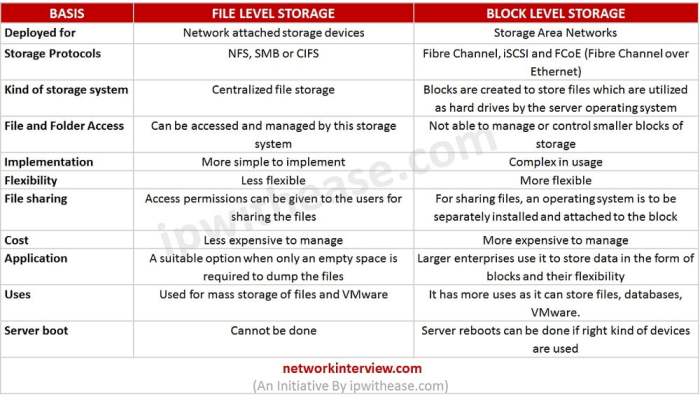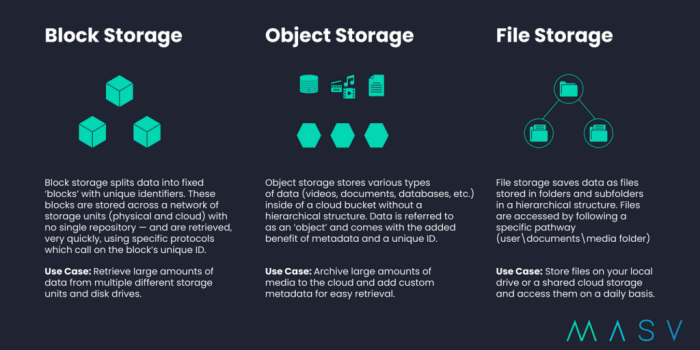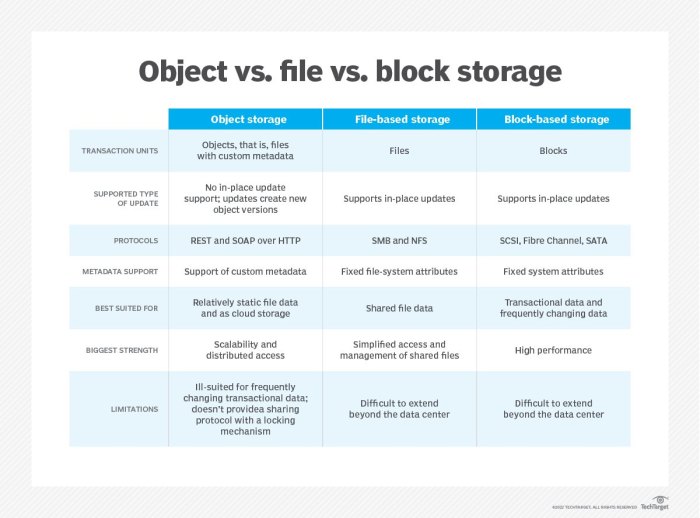Selecting the right storage solution is crucial for any modern application. Understanding the nuances of block storage and file storage is paramount to ensuring optimal performance, scalability, and cost-effectiveness. This guide delves into the critical factors that influence the decision-making process, from performance considerations to data migration strategies.
This comprehensive exploration of block and file storage will equip you with the knowledge needed to make an informed choice. We’ll cover various aspects, including use cases, performance benchmarks, scalability, and security implications. The goal is to provide a clear and concise comparison, enabling you to confidently select the optimal storage solution for your specific needs.
Introduction to Storage Types
Choosing the right storage type is crucial for optimal data management and application performance. Understanding the fundamental differences between block storage and file storage is essential for making informed decisions. These distinctions lie in how data is organized and accessed, influencing the suitability for specific workloads.Block storage and file storage represent different approaches to organizing and accessing data on a storage device.
Their varying characteristics make them suitable for different types of applications and data management requirements. Understanding these differences is paramount for architects and developers to ensure that the chosen storage solution aligns with the specific needs of their systems.
Block Storage
Block storage treats data as a series of independent blocks, each identified by a unique address. Applications directly interact with these blocks, reading and writing data to specific locations. This direct access provides high performance and control, making it ideal for applications demanding low latency and high throughput. This approach is commonly used in databases, virtualization environments, and high-performance computing.
File Storage
File storage organizes data into hierarchical structures of files and directories. Applications interact with data through these files, rather than individual blocks. This approach offers a simpler interface, making it easier to manage and share data. File storage is often preferred for general-purpose computing tasks, such as storing documents, images, and videos, where ease of use and file-level access are prioritized.
Comparison of Storage Types
The table below summarizes the key characteristics and typical use cases for both block storage and file storage.
| Storage Type | Description | Typical Use Case | Key Characteristics |
|---|---|---|---|
| Block Storage | Data is organized as independent blocks with unique addresses. Applications directly access these blocks. | Databases, virtualization, high-performance computing, large-scale data processing | High performance, low latency, fine-grained control, complex configurations, often requires specialized software. |
| File Storage | Data is organized into files and directories. Applications interact with data through these files. | General-purpose computing, document management, web serving, collaboration tools | Simple interface, easier management and sharing, suitable for varied data types, potentially lower performance for certain applications. |
Performance Considerations
Choosing between block and file storage hinges significantly on performance requirements. Understanding the speed, efficiency, and latency implications is crucial for selecting the optimal storage solution. Different applications have varying performance needs, and the appropriate storage type should align with these needs.Block storage, known for its raw speed, offers a direct path to data access. File storage, while potentially slower in certain operations, provides a more user-friendly interface for data organization.
Latency, the delay in data retrieval, plays a significant role in application performance. I/O operations, or input/output operations, directly impact system responsiveness. Understanding these factors allows for informed decisions that ensure optimal application performance.
Block Storage Performance
Block storage excels in high-throughput scenarios. Its direct access to data blocks enables exceptionally fast read and write operations, especially beneficial for applications requiring rapid data transfer. This direct access minimizes overhead, leading to significant performance gains. Database systems, virtualization platforms, and other demanding applications frequently leverage block storage for its speed and efficiency.
File Storage Performance
File storage, often used for general-purpose data storage, is well-suited for applications requiring file-based organization. While read and write speeds might be slower than block storage in some cases, file storage offers a familiar, user-friendly interface. File-based systems often prioritize features like file management and metadata manipulation. Applications needing more complex file operations, like those common in content management systems or collaboration platforms, often prefer file storage.
Latency Impact on Application Performance
Latency, the time taken to retrieve data, significantly impacts application performance. High latency can lead to slower response times, decreased user satisfaction, and reduced application throughput. In real-world scenarios, minimizing latency is paramount. For instance, an e-commerce platform experiencing high latency could see a decline in sales conversions due to slow page load times. Similarly, a database system with high latency will result in slower query responses.
Impact of I/O Operations on System Responsiveness
Input/output (I/O) operations are fundamental to system performance. High volumes of I/O operations can saturate the system, leading to performance bottlenecks. The impact is directly proportional to the volume of I/O requests and the speed of the storage system. In scenarios with heavy I/O demands, the choice of storage can significantly influence system responsiveness. For example, a web server experiencing high I/O requests from users might benefit from a fast storage system to maintain optimal performance.
Storage Type Performance Metrics
| Storage Type | Read Speed (MB/s) | Write Speed (MB/s) | Latency (ms) | Typical Use Cases |
|---|---|---|---|---|
| Block Storage | > 1000 | > 1000 | < 1 | Databases, virtual machines, high-performance computing |
| File Storage | 100-1000 | 10-1000 | 1-10 | General-purpose file sharing, web servers, content management systems |
This table provides a general overview of performance metrics. Specific values will vary based on the specific storage device, configuration, and workload.
Scalability and Flexibility
Choosing between block and file storage often hinges on the scalability requirements and flexibility needed to accommodate diverse data types and access patterns. Understanding these aspects is crucial for ensuring that your storage solution can adapt to future growth and evolving data needs. This section delves into the scalability options available with each type, and how they address differing data characteristics.Block storage offers distinct scalability characteristics compared to file storage, influencing the suitability of each for various use cases.
Flexibility in data access and management is also a key consideration. Analyzing these attributes is vital for making informed decisions regarding storage architecture.
Scalability Options for Block Storage
Block storage’s scalability is typically achieved through the addition of storage volumes. This allows for linear expansion of storage capacity as the need arises. The underlying infrastructure, often employing redundant arrays of independent disks (RAID), contributes to high availability and data protection. Modern block storage systems also incorporate features like snapshots and cloning to simplify data backup and recovery, facilitating scalability by enabling efficient data management.
This approach also helps to accommodate growing storage demands.
Flexibility of File Storage for Diverse Data Types and Access Patterns
File storage excels in accommodating diverse data types, from structured documents to unstructured multimedia files. Its hierarchical structure allows for intuitive organization and retrieval of files. Furthermore, file storage is often preferred for applications that require flexible access patterns, such as content management systems and collaborative platforms. Its accessibility and straightforward organization facilitate data sharing and collaboration.
Comparison of Scalability Features
Block storage generally exhibits simpler scalability through volume expansion. This is typically linear and straightforward to manage, though it might require dedicated infrastructure management. Conversely, file storage’s scalability is often tied to the overall system capacity and the file system’s ability to handle increased load. The nature of the file system and its architecture can influence its scalability.
In essence, block storage is often more predictable in terms of scaling, whereas file storage scalability depends on a combination of factors.
Factors Influencing Block Storage Scalability
Several factors influence the scalability of block storage. These include the underlying storage array technology, RAID configuration, and the number of available storage volumes. Also, the network bandwidth connecting storage devices to the system plays a crucial role in performance and overall scalability.
Factors Influencing File Storage Scalability
The scalability of file storage is influenced by factors such as the file system type, the number of concurrent users accessing the storage, and the overall system capacity. Moreover, network bandwidth plays a significant role in performance and scalability, as it impacts the speed of data transfer and access. Data access patterns and file size distribution can also affect the performance and overall scalability of file storage.
Summary Table: Scalability Options
| Feature | Block Storage | File Storage |
|---|---|---|
| Scalability Approach | Linear expansion of storage volumes | Dependent on system capacity and file system |
| Data Types | Supports various data types, but primarily structured data | Excellent for diverse data types, including unstructured data |
| Access Patterns | Typically supports random access to data | Often supports sequential and random access, with optimized performance for sequential access |
| Management | Usually requires more direct system administration | Often easier to manage and use, with user-friendly interfaces |
| Scalability Factors | Storage array technology, RAID configuration, volume count, network bandwidth | File system type, concurrent users, system capacity, network bandwidth, data access patterns |
Data Management and Security
Choosing between block and file storage involves careful consideration of data management and security procedures. Both methods offer unique approaches to handling data, impacting how it’s organized, accessed, and protected. Understanding the security measures associated with each is crucial for selecting the optimal solution for a given application.
Data Management Processes in Block Storage
Block storage treats data as independent blocks, allowing for granular control over data management. Data is organized into logical blocks, each addressed individually, providing a high degree of flexibility in managing storage space. This granular control allows for efficient allocation and deallocation of storage space, enabling dynamic adjustment to changing storage needs. Furthermore, block storage facilitates efficient data replication and redundancy, contributing to data availability and disaster recovery.
Security Measures in File Storage
File storage, on the other hand, organizes data into files and directories, facilitating simpler user interaction. Security measures in file storage systems often focus on access control lists (ACLs), which define permissions for different users and groups. These ACLs control read, write, and execute privileges, providing a structured approach to data access management. Furthermore, encryption of files is a common security measure, protecting sensitive information even if the storage system is compromised.
Comparison of Security Measures
The security approaches differ significantly. Block storage typically relies on the operating system or storage array for security management. File storage often incorporates built-in security features within the file system itself. This table highlights key differences:
| Feature | Block Storage | File Storage |
|---|---|---|
| Data Access Control | Managed through the underlying operating system or storage array, offering granular control over block-level access. | Controlled using access control lists (ACLs) defining permissions for files and directories. |
| Encryption | Encryption is often implemented at the storage array level, potentially impacting performance. | Encryption can be applied at the file level, offering flexible control over data protection. |
| Data Integrity | Data integrity is maintained through checksums and RAID configurations. | Data integrity can be assured through checksums and file system-level error checking. |
| Disaster Recovery | Disaster recovery is often managed by replicating blocks across multiple storage arrays. | Disaster recovery strategies typically involve backing up entire file systems or specific files. |
Data Integrity and Recovery Strategies
Data integrity is paramount in both storage types. In block storage, checksums verify data accuracy, while RAID configurations (Redundant Array of Independent Disks) ensure data redundancy and fault tolerance, mitigating data loss in case of hardware failure. File storage systems often incorporate checksums to detect data corruption and error correction mechanisms to ensure data integrity. Recovery strategies for block storage typically involve replicating data to multiple locations, while file storage often relies on backup solutions to restore lost or corrupted data.
Security Considerations
Security in storage systems is a multifaceted issue, requiring a comprehensive approach that considers both the storage method and the application’s specific needs.
Both block and file storage require robust security measures to protect sensitive data. The choice between them depends on the specific security requirements of the application, the desired level of control, and the complexity of data management processes. Understanding these considerations is essential for making an informed decision.
Cost Analysis
Choosing between block and file storage involves careful consideration of the associated costs. Understanding the different pricing models and factors influencing storage expenses is crucial for making an informed decision. This analysis explores the typical cost structures for both storage types, enabling a comparison of their overall expense implications.Cost structures for storage solutions are multifaceted and depend on various factors, including the chosen vendor, the specific storage type, and the volume of data being stored.
Analyzing these nuances allows for a more precise assessment of the total cost of ownership (TCO) for each storage solution.
Block Storage Cost Structure
Block storage pricing often involves a combination of per-gigabyte storage charges and per-I/O (input/output) operations fees. The per-gigabyte rate is typically dependent on the storage capacity, while the per-I/O charge is influenced by the frequency and type of access. Some vendors may offer tiered pricing models, providing lower per-gigabyte costs for larger storage volumes. Predictable I/O patterns are often crucial for optimizing block storage costs.
For example, a database that requires high read/write operations might necessitate a different pricing model compared to an archival storage solution.
File Storage Cost Structure
File storage pricing mechanisms can vary significantly, encompassing different pricing models, such as per-gigabyte storage fees, and pricing tied to bandwidth usage. Pricing models often reflect the level of access control, data management features, and service level agreements (SLAs) offered by the vendor. Cloud-based file storage solutions often use tiered pricing, offering lower per-gigabyte rates for larger storage capacities.
Additional costs can include network bandwidth usage, which is directly related to the frequency and size of file transfers. For example, a company relying heavily on file sharing might experience substantial costs if not carefully managed.
Comparison of Block and File Storage Costs
While both block and file storage options have their unique cost structures, a comprehensive comparison involves several factors. Consider the following factors:
- Storage Capacity: Block storage often offers better economies of scale for very large storage needs, whereas file storage might be more suitable for managing a smaller, rapidly evolving collection of files.
- Performance Requirements: Block storage is typically faster for applications demanding high I/O performance, while file storage is more suitable for tasks like file sharing or retrieval.
- Data Management Complexity: Block storage generally necessitates more intricate data management and often requires a deeper level of technical expertise for setup and maintenance, compared to file storage, which might be more user-friendly for simpler scenarios.
- Operational Overhead: Block storage solutions may involve higher operational overhead costs for managing storage devices and their associated infrastructure. This cost could be offset by the improved performance offered by block storage.
Factors Affecting Storage Costs
The cost of storage is not static and depends on various factors beyond the chosen storage type.
- Storage Tiering: Employing different storage tiers, such as hot, warm, and cold storage, allows businesses to optimize storage costs by storing less-frequently accessed data in cheaper, lower-performance tiers.
- Data Compression: Implementing data compression techniques can reduce the amount of storage space required, leading to lower storage costs.
- Data Deduplication: Removing redundant data can save storage space and reduce costs. This is especially valuable for data-intensive applications.
- Storage Efficiency: Employing storage technologies that maximize storage capacity and minimize wasted space can reduce costs significantly.
Cost Comparison Table
The table below contrasts key cost-related factors for block and file storage.
| Factor | Block Storage | File Storage |
|---|---|---|
| Pricing Model | Per-gigabyte storage + per-I/O | Per-gigabyte storage + bandwidth |
| Performance | High I/O performance | Good for file sharing |
| Scalability | Excellent scalability for large datasets | Good scalability for file sharing |
| Management Complexity | Higher management complexity | Lower management complexity |
| Cost Efficiency (large volumes) | Potentially more cost-effective | Potentially more cost-effective for specific use cases |
Integration with Existing Systems

Selecting the appropriate storage type hinges significantly on its compatibility with existing applications and infrastructure. Understanding the integration nuances between block and file storage, and how they interact with various application environments, is crucial for a seamless transition. Careful consideration of integration challenges and strategies will ultimately contribute to a more efficient and effective storage solution.
Integration Challenges with Block Storage
Block storage, while offering high performance, presents specific integration challenges for certain applications. Direct interaction with the underlying storage blocks often requires specialized drivers and programming knowledge. Complex application logic might need adjustments to accommodate the block-level access paradigm. For instance, applications relying on familiar file system APIs might face substantial rewriting efforts. Furthermore, managing block storage often involves more manual configuration and administration tasks compared to file systems, increasing operational overhead.
Integration with File Storage
File storage, with its familiar file system interface, typically integrates more smoothly with a wider range of applications. The well-established APIs and protocols allow applications to leverage existing file handling capabilities. This seamless interaction simplifies the integration process and reduces the need for substantial code modifications. Consequently, the adoption of file storage can often be faster and less disruptive.
However, the inherent limitations of file storage in handling large amounts of data or demanding I/O patterns might still require careful consideration.
Comparison of Integration Processes
Block storage integration demands a deeper understanding of storage devices and often involves more programming effort. This approach often results in a more tailored solution, allowing for fine-grained control over data access and performance. In contrast, file storage often provides a more user-friendly and familiar interaction paradigm, requiring less adaptation from existing applications.
Integration Strategies
Various integration strategies can be employed, each with its own advantages and disadvantages. One approach involves using application-specific drivers for block storage, allowing for optimized performance. Another strategy involves using file system emulators to present block storage as a familiar file system interface. Furthermore, using object storage in conjunction with block or file storage can be an effective approach to handle large amounts of data.
Integration Strategies Advantages/Disadvantages
- Application-Specific Drivers (Block Storage): Offers optimized performance, but requires significant development effort and maintenance. Suitable for demanding applications needing fine-grained control.
- File System Emulators (Block Storage): Simplifies integration for existing applications, but might introduce performance overhead. Good for applications that cannot be easily adapted.
- Object Storage with Block/File Storage: Offers scalability, cost-effectiveness, and flexibility, but may introduce complexity for some applications. Suitable for applications requiring massive data storage.
Potential Integration Points
The following table Artikels potential integration points for both block and file storage, highlighting the differences in access methods and interaction paradigms.
| Integration Point | Block Storage | File Storage |
|---|---|---|
| Application Level API | Low-level, device-specific drivers | High-level, file-system-oriented APIs |
| Data Access Methods | Direct block access, often with custom libraries | File-oriented access, leveraging existing file system operations |
| Data Management | Often involves direct interaction with storage arrays | Typically managed through the file system interface |
| Scalability | High scalability through storage array configurations | Scalability depends on the file system architecture |
Use Cases and Examples
Choosing between block and file storage often hinges on the specific needs of the application. Understanding the characteristics of each storage type and their suitability for various use cases is crucial for optimal system design and performance. This section provides real-world examples, highlighting the benefits and drawbacks of each approach.
Block Storage Applications
Block storage excels in applications demanding high performance and predictable access times. Its inherent nature as raw storage, accessed by block numbers, allows for direct control and efficient data transfer. This is particularly valuable for applications where low-latency access is critical.
- Databases: Relational databases, such as MySQL and PostgreSQL, often leverage block storage for their data tables and indexes. The direct access to data blocks enables rapid retrieval and updates, crucial for transaction processing and query performance. This is often preferable to file-based systems due to the efficiency of block-level operations. The structured nature of block storage allows for optimized data placement, further enhancing database performance.
- Virtual Machines (VMs): Block storage is the primary storage for virtual machines, enabling quick instantiation and efficient data transfer. The storage is presented as raw blocks to the virtual machine, allowing it to interact directly with the storage. This results in higher performance compared to file-based systems when accessing the storage, facilitating quicker VM boot times and faster application responses.
- High-Performance Computing (HPC): Applications in HPC, like scientific simulations and data analysis, benefit significantly from block storage. The ability to access data blocks directly and the low latency associated with block storage enable faster data processing and simulation speeds, ultimately reducing overall processing time.
File Storage Implementations
File storage, with its hierarchical structure, is suitable for applications that require easy data organization and access through files and directories. This makes it a strong choice for applications where data organization and user-friendly interaction are key.
- Web Servers: Web servers, hosting websites and web applications, use file storage for storing web pages, images, and other static content. The hierarchical structure of file storage allows for efficient organization and retrieval of these resources, facilitating faster page loading and better user experience. This is a common implementation due to the ease of managing files and directories.
- Content Management Systems (CMS): CMS platforms, like WordPress and Drupal, rely on file storage for managing and storing user-generated content, images, and documents. The straightforward structure of file storage makes it easy for users to interact with and manage content. It simplifies the workflow, improving overall user experience.
- Data Archiving: Large-scale data archiving often employs file storage for long-term data preservation. File storage systems are designed to handle various file types and formats, making them suitable for storing diverse data sets for later retrieval. The ease of organization and search functionality within file storage systems is a crucial aspect for long-term archiving.
Comparing Use Cases
The choice between block and file storage depends on the specific needs of the application. High-performance applications, such as databases and VMs, typically favor block storage due to its low latency and direct access capabilities. Applications focused on data organization and user interaction, such as web servers and CMS platforms, often benefit from the structured nature of file storage.
Scenarios Favoring One Type of Storage
- High-Transaction Databases: Block storage is more suitable due to its low latency and high throughput characteristics, critical for handling large volumes of transactions efficiently.
- Data-Intensive Applications: Block storage, with its high performance, is often the preferred choice for applications that require rapid data access and manipulation.
- Large-Scale Archiving: File storage’s hierarchical structure and robust file management capabilities make it a more suitable choice for long-term data archiving and preservation.
Choosing the Right Storage Type
Deciding between block and file storage is a critical step in any storage architecture design. The optimal choice hinges on careful evaluation of specific application requirements, data characteristics, and long-term strategic goals. Understanding the nuances of each storage type and their respective strengths and weaknesses is essential for making an informed decision.Selecting the appropriate storage solution requires a systematic approach that considers the interplay between performance, scalability, data management, security, and cost.
This process necessitates a thorough understanding of the application’s demands and the specific characteristics of the data to be stored.
Key Factors for Choosing Block Storage
Block storage, characterized by its raw, low-level access, is ideally suited for applications demanding high performance and predictable I/O patterns. This approach is particularly well-suited for applications that require extremely fast data access, such as high-frequency trading systems or large-scale databases. Its ability to provide fine-grained control over storage resources makes it a popular choice for applications with specialized needs.
- High Performance: Block storage excels in applications requiring rapid data access due to its low-level interface. This makes it suitable for high-transaction systems, database management, and applications where response time is critical.
- Predictable I/O: Block storage offers predictable performance, ensuring consistent access times, a critical factor for applications with strict latency requirements. This characteristic translates into enhanced system reliability and efficiency.
- Fine-grained Control: Administrators have granular control over storage resources, allowing for optimized allocation and management. This level of control is crucial for specialized configurations or demanding environments.
- Scalability: Block storage systems often offer scalability in terms of capacity and performance through the addition of more storage devices. This scalability is particularly valuable for rapidly growing applications.
Key Factors for Choosing File Storage
File storage, offering a user-friendly interface, is suitable for applications with unstructured data or less stringent performance needs. This approach is commonly used for storing documents, images, and videos. The simplicity and ease of use of file storage systems make them a desirable option for general-purpose storage.
- Ease of Use: File storage’s user-friendly interface simplifies data management and access, making it a popular choice for applications where data management is not a primary concern.
- Data Organization: File storage provides a hierarchical structure for organizing data, making it straightforward to manage and locate files. This structure is particularly valuable for storing and retrieving large collections of files.
- Unstructured Data Handling: File storage systems are designed to handle a wide variety of file types, including documents, images, videos, and more. This versatility is a key advantage for storing diverse data sets.
- Cost-Effectiveness: In certain scenarios, file storage can be more cost-effective than block storage for applications with less demanding performance requirements.
Decision Matrix for Block vs. File Storage
The following matrix provides a simplified framework for evaluating storage requirements and choosing the appropriate storage type.
| Factor | Block Storage | File Storage |
|---|---|---|
| Performance | High | Moderate |
| Scalability | High | Moderate |
| Data Organization | Low-level | Hierarchical |
| Ease of Use | Complex | Simple |
| Cost | Potentially Higher | Potentially Lower |
| Data Type | Structured, demanding performance | Unstructured, diverse file types |
The choice between block and file storage hinges on a careful assessment of the specific needs of the application. Understanding the data characteristics, performance requirements, and scalability needs is paramount.
Data Migration Strategies

Migrating data between storage types, particularly from file to block storage or vice versa, is a critical process demanding careful planning and execution. Successful migrations often depend on understanding the nuances of both storage systems and the data itself. This section explores strategies for data migration, highlighting challenges and considerations, and presenting successful examples.
Strategies for Migrating Data from File Storage to Block Storage
Migrating from file storage to block storage often involves converting data structures and potentially altering access methods. The primary goal is to leverage the performance and efficiency benefits of block storage while maintaining data integrity.
- Data Conversion and Formatting: This crucial step involves transforming the data from its file-based format into a format compatible with block storage. Tools and scripts are typically employed for this process. This often requires understanding the file system’s structure and how it relates to block storage. For example, converting a file structure like a hierarchical directory system to a block-based mapping scheme is essential.
- Data Replication and Validation: Duplicate the data to the new block storage. Employ robust mechanisms to verify data integrity and ensure consistency between the source and destination. A common technique involves comparing checksums or using specialized tools to validate the transferred data against the original. Tools that support checksumming and block-level comparisons are vital to verify data integrity.
- Incremental Migration Strategies: For large datasets, an incremental migration approach is preferred over a complete, one-time transfer. This involves transferring data in batches, allowing for periodic validation checks and minimizing downtime. Regular checkpoints ensure that the migration process is monitored for accuracy and that data is not lost.
Strategies for Migrating Data from Block Storage to File Storage
Migrating from block storage to file storage necessitates a change in how data is accessed and managed. Careful planning is essential to ensure a smooth transition.
- Data Extraction and Formatting: The initial step involves extracting data from the block storage and formatting it for a file-based system. Tools designed for block storage access are necessary for retrieving the data. This stage requires meticulous consideration of the target file system’s structure.
- File System Creation and Organization: Creating a structured file system on the target storage is crucial. This often involves defining folders, subfolders, and file naming conventions to mirror the original data organization as closely as possible. Understanding the original data structure is key.
- Data Validation and Verification: Similar to the previous migration, validation is critical. Employing techniques to verify the integrity of the data after the migration is essential. Checksum comparisons and other validation methods are standard practices.
Challenges and Considerations for Data Migration
Data migration projects present several challenges, which need careful consideration.
- Data Volume and Complexity: The size and complexity of the data significantly impact the migration process. Large datasets require substantial resources and time. Proper planning and resource allocation are critical.
- Performance and Downtime: Minimizing downtime during migration is paramount. Strategies like incremental transfer and scheduled downtime can help. Efficient tools and careful planning are crucial to ensure smooth transitions.
- Data Integrity and Consistency: Maintaining data integrity throughout the migration process is vital. Regular validation checks and verification mechanisms are essential. Errors at this stage can lead to significant problems.
Examples of Successful Data Migration Projects
Many successful data migration projects exist, highlighting best practices.
- Large-scale e-commerce platforms have successfully migrated their product catalogs from file storage to block storage to improve performance and scalability.
- Financial institutions have migrated transaction data from block storage to file storage for regulatory compliance and audit purposes.
Data Migration Process Flowchart
A flowchart detailing the data migration process, from initial planning to post-migration validation, would be beneficial. However, due to the limitations of text-based formatting, a visual flowchart cannot be created here. A visual representation would depict the steps more effectively, including decisions at each stage.
Future Trends and Advancements

The landscape of storage technologies is constantly evolving, driven by the ever-increasing demands for data capacity, speed, and efficiency. Understanding these emerging trends is crucial for making informed decisions about storage infrastructure. Anticipating the future of block and file storage will allow organizations to stay ahead of the curve and ensure their systems remain robust and scalable.Future storage solutions are poised to address the limitations of current technologies.
This involves exploring new materials, innovative architectures, and advancements in data management to meet the growing need for reliable and efficient data storage. The potential advancements in both block and file storage will profoundly impact the design and implementation of storage systems, demanding careful consideration for seamless integration with existing infrastructure.
Potential Developments in Block Storage
Block storage, characterized by its direct access to data blocks, is expected to continue its evolution toward higher performance and scalability. Advanced technologies like NVMe (Non-Volatile Memory Express) are likely to play a significant role in this evolution, enabling faster data transfer rates and lower latency. Furthermore, the incorporation of artificial intelligence (AI) and machine learning (ML) algorithms into storage systems could enhance data management efficiency and performance.
The integration of intelligent caching and data placement strategies will further refine block storage solutions.
Emerging Trends in File Storage Solutions
File storage, offering a more user-friendly approach, is likely to see significant improvements in efficiency and scalability. Cloud-based file storage solutions are poised to grow in popularity, offering greater flexibility and accessibility. Advancements in data compression and deduplication techniques will likely reduce storage space requirements and improve data retrieval speed. This trend is driven by the rising need for secure, easily accessible, and scalable file management systems, particularly for large-scale enterprises.
Comparison of Predicted Advancements
While both block and file storage are expected to improve, the specific advancements and their impact might differ. Block storage is predicted to focus on raw performance and scalability, particularly in high-performance computing (HPC) environments. Conversely, file storage is more likely to emphasize ease of use, accessibility, and integration with cloud services. The predicted improvements in data management tools and data protection measures will be crucial for both storage types.
Impact on Future Storage Decisions
The future advancements in both block and file storage will necessitate a more strategic approach to storage selection. Organizations will need to carefully evaluate their specific needs, considering factors such as data access patterns, performance requirements, and scalability needs. The integration of emerging technologies, such as AI and machine learning, into storage systems will likely influence the decision-making process.
Potential Future Directions
Future block storage solutions will likely prioritize faster data transfer speeds, enhanced security, and simplified management. File storage systems, on the other hand, are anticipated to focus on seamless cloud integration, improved data accessibility, and enhanced collaboration features. The adoption of AI and machine learning will potentially influence both storage types, leading to automated data management and optimized storage utilization.
Last Recap
In conclusion, choosing between block and file storage involves a careful evaluation of several key factors. The optimal choice hinges on the specific requirements of your application, including performance needs, scalability expectations, data management strategies, and cost considerations. This guide has provided a structured framework for making informed decisions, ensuring you select the storage solution that aligns best with your current and future goals.
Questions Often Asked
What are the key differences in performance between block and file storage?
Block storage typically offers superior performance for applications requiring high I/O operations, like databases or transaction-heavy systems. File storage, on the other hand, is often favored for applications with simpler access patterns and larger files.
How does data security differ between the two types of storage?
Both block and file storage offer security measures, but block storage often relies on the application layer for data integrity and access control, while file storage usually employs a combination of operating system and application-level security.
What are some common use cases for block storage?
Block storage is frequently used in database systems, virtual machines, and applications demanding high throughput and low latency.
What are the typical cost implications of implementing file storage?
File storage costs are often driven by factors like storage capacity, access frequency, and the complexity of the file system. Pricing models vary greatly, depending on the provider.


